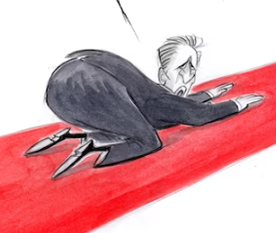Saturday Smorgasbord
Skip to commentsThe Return of Philbert Phountain

Phil Fountain is a pseudonym for ANC’s prodigal cartoonist, Philbert Phountain, who has recently returned from a working hiatus where he served as the lead fact-checker for George Santos.
After a lengthy sabbatical cartoonist Phil Fountain has returned to the political battlefield of Northern California contributing to A News Cafe.
Jack Kirby’s Fantastic Four Comic Strip

TwoMorrows’ Jack Kirby Collector #85 is due in comics shops Jan. 18 and this one is especially groovy — an exploration of the King’s work in animation.
The mag is absolutely jammed with goodies but for our EXCLUSIVE EXCERPT, we bring you a three-page set of Kirby storyboards for the final episode of 1978-79’s The New Fantastic Four — “Blastaar, The Living Bomb-Burst” (based on Fantastic Four #63).
Okay it’s a storyboard not a comic strip, but it’s close and it’s pure Jack Kirby! 13th Dimension has the preview.
More about the animated Jack Kirby at Ruby Spears from Cartoon Research.
The Calendar Cartoons of Clyde Lamb

Clyde Lamb was serving two consecutive 25 years in the Indiana State Penitentiary when he began painting and drawing cartoons for the amusement of his fellow inmates. Encouraged to submit his drawings to magazines, Lamb gave it a shot and soon his work appeared in Judge. Collier’s, The Saturday Evening Post and This Week Magazine soon followed. Paroled in 1947, he returned to his Montana birthplace, re-married the wife he divorced while in prison and enjoyed a successful career as free-lance gag cartoonist. He also continued to paint.
In the late 1950’s Lamb found a home for his oils with Brown & Bigelow…
Mike Lynch and Dick Buchanan gift us with a score of Clyde Lamb (mostly sports related) calendar painted gags.
Secret Agent X-9, When Alex Raymond Was a Great Comic Strip Artist Instead of Illustrator



Jan. 22 1934, the collaboration between Dashiell Hammett and Alex Raymond launched as Secret Agent X-9. Designed to respond to Dick Tracy’s massive success with the literary cachet of Hammett and the rising talent of Raymond, X-9 looked better on paper perhaps than it did, well, on the actual page. The famous innovator of the hard-boiled style was at the tail end of his productive output and clearly did not give his best effort…
Meanwhile, the amazingly talented Raymond was headed in the opposite direction. The self-taught artist had been ghosting Tim Tyler’s Luck for a year when he floated to the top of a competition that William Randolph Hearst and syndicate editor Joe Connolly held in order to find the right artist to pair with Hammett. But it was in the first year of Raymond’s tenure on X-9, which he did in parallel with his Flash Gordon strip, that we see him mature quickly.
There’s no denying Alex Raymond is one of the greatest comic strip illustrators, but I like his early work of comic art where there was more continuity of action than the later illustrating of scenes.
Steve Smith, at Panels & Prose, looks at some early Alex Raymond comic strip art.
The [three] day sequence of strips [above] from early June, 1934 is a wonderful bit of comic strip choreography. Every limb in this protracted tussle adds a kinetic note to Raymond’s violent ballet…


Comments
Comments are closed.